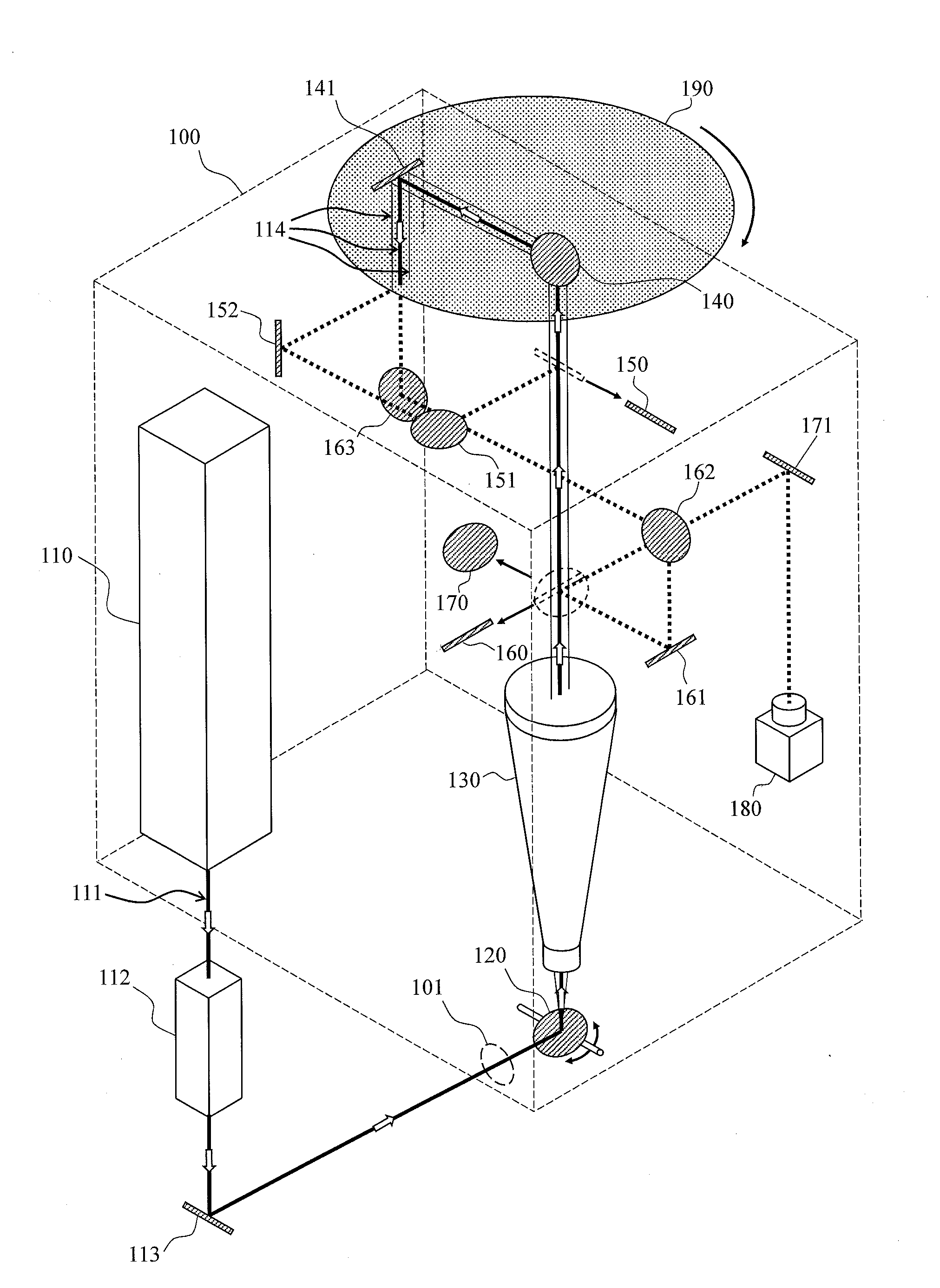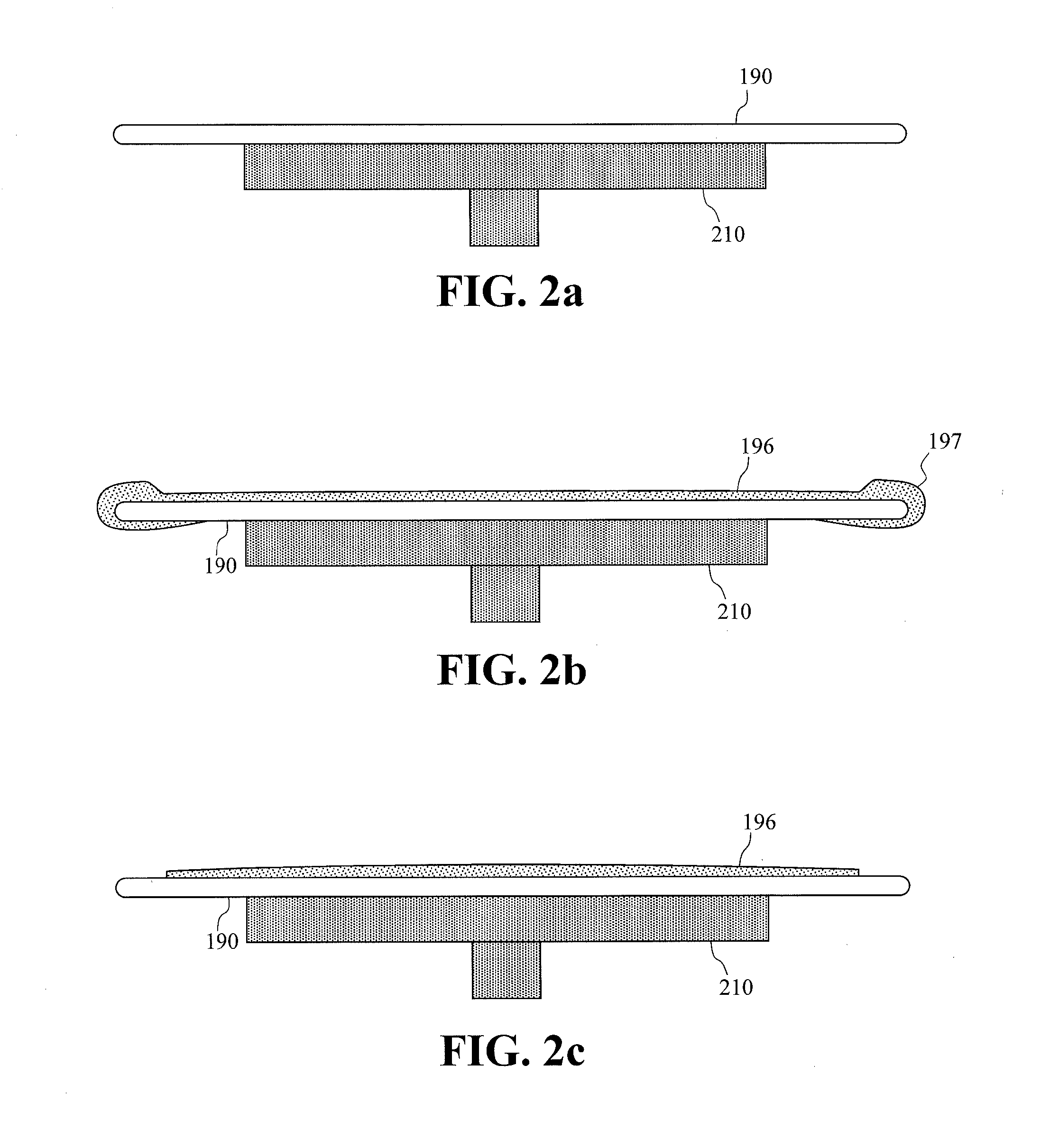Wafer edge processing in semiconductor manufacturing requires many different types of chemicals and tools, and is therefore complex and costly.
One example of a problem with the prior art relates to a method for dispensing liquid in a
solvent-based edge cleaning process, as described in U.S. Pat. No. 5,392,989 and U.S. Patent Publication No. 2010 / 0051073 A1.
This problem relates to the inability of the liquid
solvent to control the geometry of the cleaned edge.
Solvent-based edge cleaning cannot currently meet this specification due to the inability to effectively control the solvents.
This inability includes
solvent splashing onto good die causing yield loss.
Organic solvents, such as
ethyl lactate or cellosolve acetate, cause environmental problems, raise safety concerns, and are costly to use.
These chemicals are hazardous to use and require the use of complex and costly equipment, raising environmental problems and safety concerns.
As with the solvent method listed above, it is difficult to effectively control the width of the edge
exclusion zone.
This method is specifically used to remove
metal films, but due to the non-uniformity of these films at the edge of the
wafer, it is difficult to control the etch depth.
This method is also used for removing Teflon-like particles, but is not effective for removing photoresists.
Since multiple pieces of equipment are used, this increases the time to complete the process, reducing
throughput.
The
exposure step is often not adequate in removal of very thick edge beads; therefore a solvent cleaning process step is required.
This method addresses
photoresist edge beads, but there are many other types of more difficult films, such as post-etch polymers, that need to be removed, but cannot be addressed with WEE.
Another example of a problem with the prior art relates to a lithographic masking method, as described in U.S. Patent Publication No. 2007 / 0093067 A1 and U.S. Pat. No. 7,745,095 B2.
This method is complex in that at least four individual steps are required to clean the wafer edge.
This method requires multiple pieces of expensive equipment, consumes considerable volumes of solvent and water, and reduces
throughput.
Another example of a problem with the prior art relates to a method using
reactive plasma, as described in U.S. Pat. No. 7,651,585 B2 and U.S. Patent Publication No. 2010 / 0099265 A1.
Another example of a problem with the prior art relates to mechanical methods for cleaning wafer edges as described in U.S. Patent Publication No. 2010 / 0190416 A1 and U.S. Patent Publication No. 2009 / 0029629 A1.
Another example of a problem with the prior art relates to the use of frozen
carbon dioxide particles to clean wafer edges, as described in U.S. Pat. No. 7,270,136 B2.
The problems with this method are that the equipment used to perform this process is highly complex and expensive, and the
impact of the frozen particles can cause damage to the substrate and to otherwise usable die.
Another example of a problem with the prior art relates to applying a
flame to the edge of a wafer in the presence of reactive gasses including halogens and
ozone, as described in U.S. Patent Publication No. 2008 / 0010845 A1.
Nitrogen trifluoride is a highly toxic and expensive gas that is typically used to clean deposition chambers in semiconductor manufacturing.
Further, this method may require pre-heating the wafer to prevent condensation of the by-products onto the wafer, causing die loss.
The apparatus described is very complex since the gas plumbing and safety requirements are extreme for the types of gases proposed for this edge cleaning method.
Lastly, the method cannot remove films from all wafer edges in a
single step and is not effective for
photoresist removal.
Another example of a problem with the prior art relates to the use of a pressurized
stream of a non-solvent medium, which may be a gas, to clean wafer edges, as described in U.S. Patent Publication No. 2004 / 0126923 A1.
An expected problem with this method would be the scattering of particles onto the usable areas of the wafer, as well as the surrounding equipment.
Additionally, this
patent application claims that the medium must not be a solvent for the material being removed, which severely limits use on a variety of films due to its non-reactive nature.
Finally, another example of a problem with the prior art relates to the method of using an oblique-angled
nozzle containing a
laser beam combined with
inert gas, as described in U.S. Pat. No. 6,874,510 B2.
One problem with this method is that the beam used to clean the wafer edge is inside the gas delivery
nozzle, such that the gas cannot be independently directed to prevent material from falling onto the good die toward the center of the wafer.
Such laser reactions create a cloud of debris.
If the gas
nozzle is not positioned to remove this cloud away from the center of the wafer, debris will re-deposit onto good die causing yield loss.
This prior art uses a chamber, which further complicates the process of removing the debris, as it becomes confined in the chamber, and can re-deposit onto the wafer as well as build-up on the chamber walls.
Another problem with this prior art method is that the gas used is
inert, and therefore does not permit reaction with films on the wafer edges.
Yet another problem with this prior art is that this method shows cleaning only on the top surface.
However, if a source of this type were redirected to the apex, the reaction by-products would be blown onto the good die at the center of the wafer, causing significant die loss.
Still another problem with this prior art is that it requires the laser beam to impinge on the wafer edge at an
oblique angle, introducing several problems including beam
distortion and focusing issues at the wafer plane.
Due to the limitations of current edge
cleaning methods, otherwise usable space on the periphery of a wafer is consumed.
Therefore, considerable effort is given to keep the edge cleaning area, called the edge exclusion, to a minimum.
Conventional wet edge bead
cleaning methods are unable to control edge exclusion to this level due to the natural movement of liquids on smooth surfaces, such as a highly polished
silicon wafer.
 Login to View More
Login to View More 


